Vivado Design Suite User
Guide
See all versions
of this document
High-Level Synthesis
UG902 (v2019.2) January 13, 2020
�
Revision History
Revision History
The following table shows the revision history for this document.
Section
Revision Summary
01/13/2020 Version 2019.2
Updated Command Reference.
Updated command.
10/30/2019 Version 2019.2
The HLS Math Library and Fixed-Point Math Functions
Removed Gamma function.
07/12/2019 Version 2019.1
Removing False Dependencies to Improve Loop Pipelining
Clarified information on dependencies.
05/22/2019 Version 2019.1
Optimizing for Throughput
Specifying Arrays as Ping-Pong Buffers or FIFOs
Stable Arrays, set_directive_stable
Using ap_ctrl_none Inside the Dataflow
RTL Blackbox, RTL Blackbox JSON File, add_files
Waveform Viewer
SSR FFT IP Library
Updated information on dataflow and pipelining
throughout section.
Updated explanation of ping-pong buffers.
Added information on stable arrays.
Added information on using ap_ctrl_none within the
dataflow.
Added information on the new RTL blackbox feature, added
specifications for the required JSON file, and updated the
add_files command to include the -blackbox option.
Added information on the Waveform Viewer.
Added information on the new super sample data rate (SSR)
FFT.
Added new subsections:
Recommended Flow for Using SSR FFT Fixed Point
Configurations
SSR FFT IP Library Usage
UG902 (v2019.2) January 13, 2020
High-Level Synthesis
www.xilinx.com
2
Send Feedback�
Table of Contents
Revision History...............................................................................................................2
Chapter 1: High-Level Synthesis............................................................................ 5
High-Level Synthesis Benefits....................................................................................................5
High-Level Synthesis Basics....................................................................................................... 6
Understanding Vivado HLS...................................................................................................... 12
Using Vivado HLS...................................................................................................................... 19
Data Types for Efficient Hardware.......................................................................................... 71
Managing Interfaces.................................................................................................................77
Optimizing the Design............................................................................................................118
Verifying the RTL..................................................................................................................... 177
Exporting the RTL Design.......................................................................................................191
Chapter 2: High-Level Synthesis C Libraries................................................198
Arbitrary Precision Data Types Library.................................................................................198
HLS Stream Library................................................................................................................. 213
HLS Math Library.....................................................................................................................222
HLS Video Library.................................................................................................................... 232
HLS IP Libraries........................................................................................................................232
HLS Linear Algebra Library.................................................................................................... 264
HLS DSP Library.......................................................................................................................275
HLS SQL Library....................................................................................................................... 277
Chapter 3: High-Level Synthesis Coding Styles..........................................279
Unsupported C Constructs.....................................................................................................279
C Test Bench.............................................................................................................................283
Functions..................................................................................................................................290
RTL Blackbox............................................................................................................................292
Loops........................................................................................................................................ 297
Arrays........................................................................................................................................305
Data Types................................................................................................................................314
C Builtin Functions.................................................................................................................. 339
UG902 (v2019.2) January 13, 2020
High-Level Synthesis
www.xilinx.com
3
Send Feedback�
Hardware Efficient C Code..................................................................................................... 340
C++ Classes and Templates....................................................................................................358
Assertions.................................................................................................................................366
SystemC Synthesis.................................................................................................................. 369
Chapter 4: High-Level Synthesis Reference Guide...................................388
Command Reference.............................................................................................................. 388
GUI Reference..........................................................................................................................462
Interface Synthesis Reference............................................................................................... 465
AXI4-Lite Slave C Driver Reference........................................................................................483
HLS Video Functions Library.................................................................................................. 496
HLS Linear Algebra Library Functions.................................................................................. 496
HLS DSP Library Functions.....................................................................................................505
HLS SQL Library Functions..................................................................................................... 518
C Arbitrary Precision Types.................................................................................................... 521
C++ Arbitrary Precision Types................................................................................................535
C++ Arbitrary Precision Fixed-Point Types........................................................................... 555
Comparison of SystemC and Vivado HLS Types..................................................................577
RTL Blackbox JSON File........................................................................................................... 584
Appendix A: Additional Resources and Legal Notices........................... 587
Xilinx Resources.......................................................................................................................587
Documentation Navigator and Design Hubs...................................................................... 587
References................................................................................................................................587
Please Read: Important Legal Notices................................................................................. 588
UG902 (v2019.2) January 13, 2020
High-Level Synthesis
www.xilinx.com
4
Send Feedback�
Chapter 1
High-Level Synthesis
The Xilinx® Vivado® High-Level Synthesis (HLS) tool transforms a C specification into a register
transfer level (RTL) implementation that you can synthesize into a Xilinx field programmable gate
array (FPGA). You can write C specifications in C, C++, or SystemC, and the FPGA provides a
massively parallel architecture with benefits in performance, cost, and power over traditional
processors. This chapter provides an overview of high-level synthesis.
Note: For more information on FPGA architectures and Vivado HLS basic concepts, see the Introduction to
FPGA Design Using High-Level Synthesis (UG998).
High-Level Synthesis Benefits
High-level synthesis bridges hardware and software domains, providing the following primary
benefits:
• Improved productivity for hardware designers
Hardware designers can work at a higher level of abstraction while creating high-performance
hardware.
• Improved system performance for software designers
Software developers can accelerate the computationally intensive parts of their algorithms on
a new compilation target, the FPGA.
Using a high-level synthesis design methodology allows you to:
• Develop algorithms at the C-level
Work at a level that is abstract from the implementation details, which consume development
time.
• Verify at the C-level
Validate the functional correctness of the design more quickly than with traditional hardware
description languages.
• Control the C synthesis process through optimization directives
Create specific high-performance hardware implementations.
• Create multiple implementations from the C source code using optimization directives
UG902 (v2019.2) January 13, 2020
High-Level Synthesis
www.xilinx.com
5
Send Feedback�
Chapter 1: High-Level Synthesis
Explore the design space, which increases the likelihood of finding an optimal implementation.
• Create readable and portable C source code
Retarget the C source into different devices as well as incorporate the C source into new
projects.
High-Level Synthesis Basics
High-level synthesis includes the following phases:
• Scheduling
Determines which operations occur during each clock cycle based on:
Length of the clock cycle or clock frequency
•
• Time it takes for the operation to complete, as defined by the target device
• User-specified optimization directives
If the clock period is longer or a faster FPGA is targeted, more operations are completed
within a single clock cycle, and all operations might complete in one clock cycle. Conversely, if
the clock period is shorter or a slower FPGA is targeted, high-level synthesis automatically
schedules the operations over more clock cycles, and some operations might need to be
implemented as multicycle resources.
• Binding
Determines which hardware resource implements each scheduled operation. To implement
the optimal solution, high-level synthesis uses information about the target device.
• Control logic extraction
Extracts the control logic to create a finite state machine (FSM) that sequences the operations
in the RTL design.
High-level synthesis synthesizes the C code as follows:
• Top-level function arguments synthesize into RTL I/O ports
• C functions synthesize into blocks in the RTL hierarchy
If the C code includes a hierarchy of sub-functions, the final RTL design includes a hierarchy of
modules or entities that have a one-to-one correspondence with the original C function
hierarchy. All instances of a function use the same RTL implementation or block.
• Loops in the C functions are kept rolled by default
UG902 (v2019.2) January 13, 2020
High-Level Synthesis
www.xilinx.com
6
Send Feedback�
Chapter 1: High-Level Synthesis
When loops are rolled, synthesis creates the logic for one iteration of the loop, and the RTL
design executes this logic for each iteration of the loop in sequence. Using optimization
directives, you can unroll loops, which allows all iterations to occur in parallel. Loops can also
be pipelined, either with a finite-state machine fine-grain implementation (loop pipelining) or
with a more coarse-grain handshake-based implementation (dataflow).
• Arrays in the C code synthesize into block RAM or UltraRAM in the final FPGA design
If the array is on the top-level function interface, high-level synthesis implements the array as
ports to access a block RAM outside the design.
High-level synthesis creates an optimized implementation based on default behavior, constraints,
and any optimization directives you specify. You can use optimization directives to modify and
control the default behavior of the internal logic and I/O ports. This allows you to generate
variations of the hardware implementation from the same C code.
To determine if the design meets your requirements, you can review the performance metrics in
the synthesis report generated by high-level synthesis. After analyzing the report, you can use
optimization directives to refine the implementation. The synthesis report contains information
on the following performance metrics:
• Area: Amount of hardware resources required to implement the design based on the resources
available in the FPGA, including look-up tables (LUT), registers, block RAMs, and DSP48s.
• Latency: Number of clock cycles required for the function to compute all output values.
• Initiation interval (II): Number of clock cycles before the function can accept new input data.
• Loop iteration latency: Number of clock cycles it takes to complete one iteration of the loop.
• Loop initiation interval: Number of clock cycles before the next iteration of the loop starts to
process data.
• Loop latency: Number of cycles to execute all iterations of the loop.
Scheduling and Binding Example
The following figure shows an example of the scheduling and binding phases for this code
example:
int foo(char x, char a, char b, char c) {
char y;
y = x*a+b+c;
return y;
}
UG902 (v2019.2) January 13, 2020
High-Level Synthesis
www.xilinx.com
7
Send Feedback�
Chapter 1: High-Level Synthesis
Figure 1: Scheduling and Binding Example
Clock Cycle
Scheduling
Phase
1
*
a
x
b
c
2
3
+
y
+
Initial Binding
Phase
Target Binding
Phase
Mul
AddSub
AddSub
DSP48
AddSub
X14220-061518
In the scheduling phase of this example, high-level synthesis schedules the following operations
to occur during each clock cycle:
• First clock cycle: Multiplication and the first addition
• Second clock cycle: Second addition and output generation
Note: In the preceding figure, the square between the first and second clock cycles indicates when an
internal register stores a variable. In this example, high-level synthesis only requires that the output of the
addition is registered across a clock cycle. The first cycle reads x, a, and b data ports. The second cycle
reads data port c and generates output y.
In the final hardware implementation, high-level synthesis implements the arguments to the top-
level function as input and output (I/O) ports. In this example, the arguments are simple data
ports. Because each input variable is a char type, the input data ports are all 8-bits wide. The
function return is a 32-bit int data type, and the output data port is 32-bits wide.
IMPORTANT! The advantage of implementing the C code in the hardware is that all operations finish in a
shorter number of clock cycles. In this example, the operations complete in only two clock cycles. In a central
processing unit (CPU), even this simple code example takes more clock cycles to complete.
In the initial binding phase of this example, high-level synthesis implements the multiplier
operation using a combinational multiplier (Mul) and implements both add operations using a
combinational adder/subtractor (AddSub).
UG902 (v2019.2) January 13, 2020
High-Level Synthesis
www.xilinx.com
8
Send Feedback�

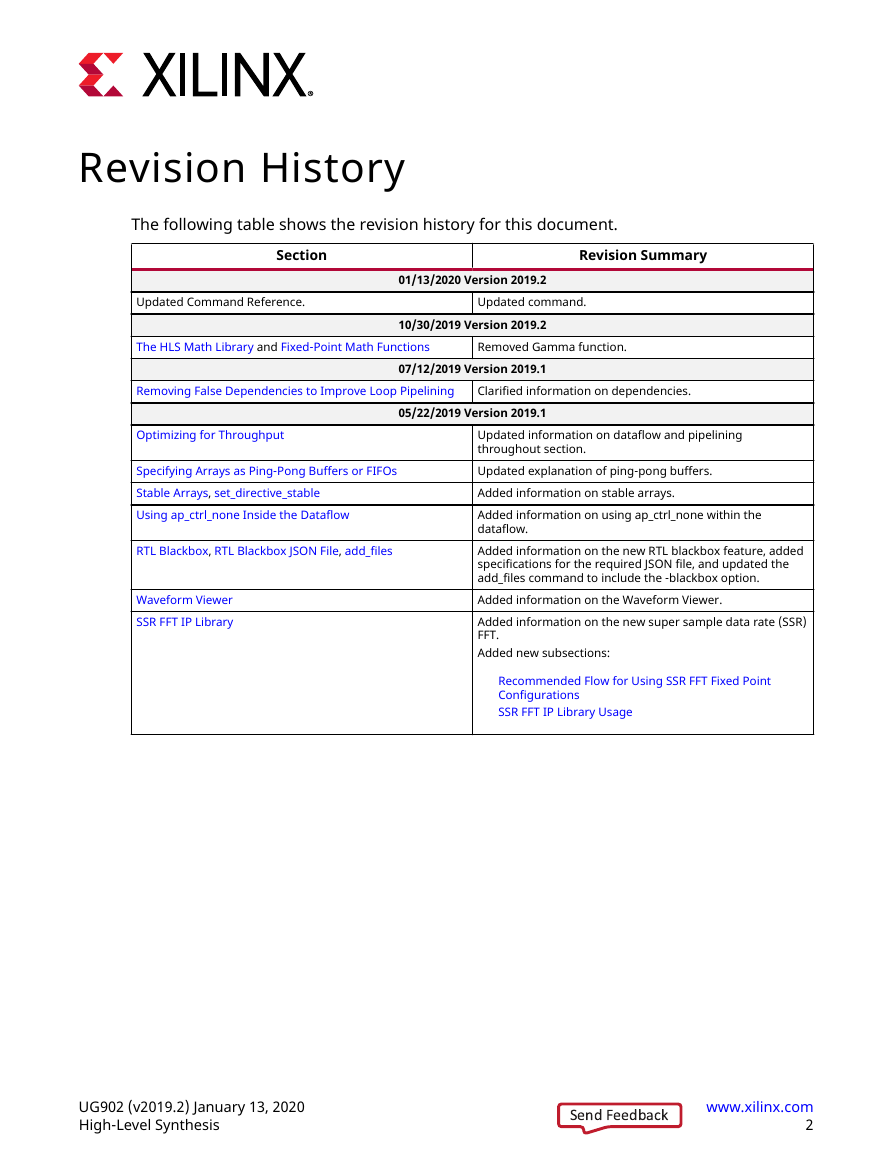

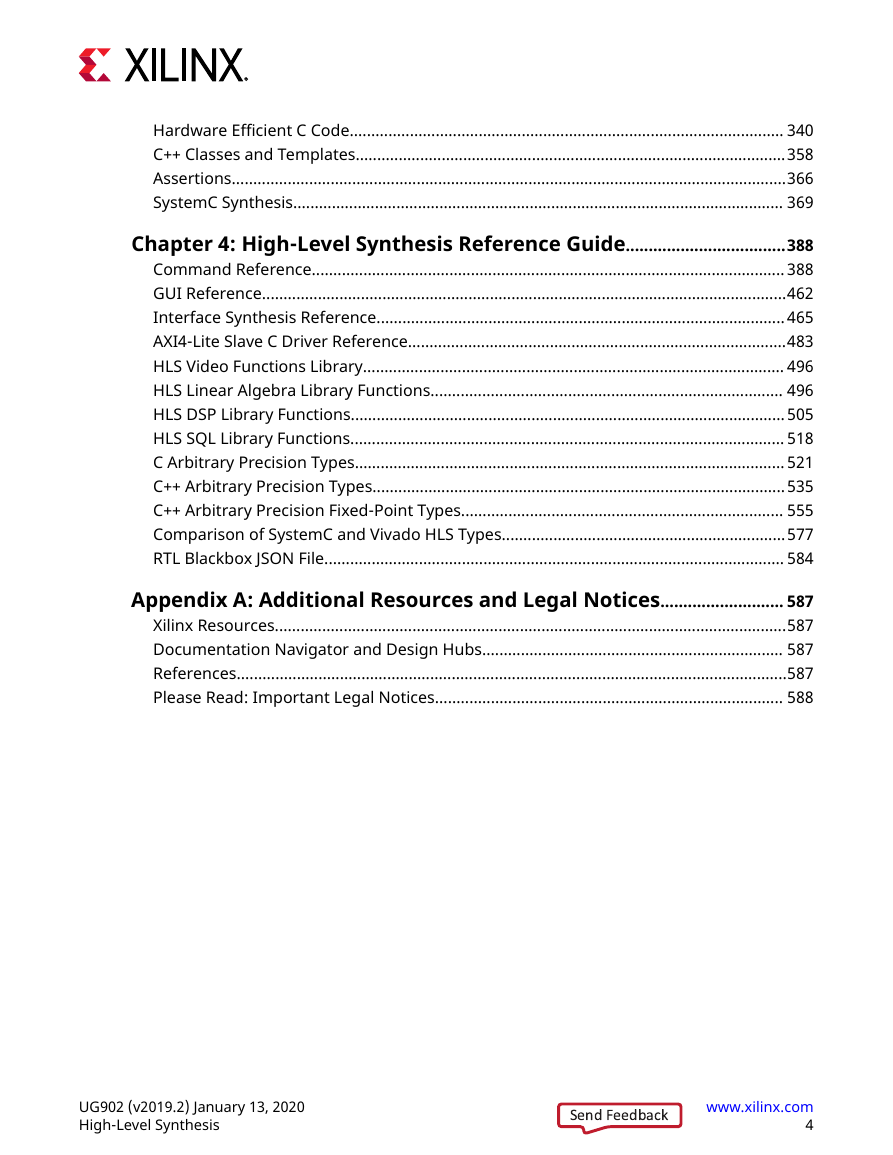

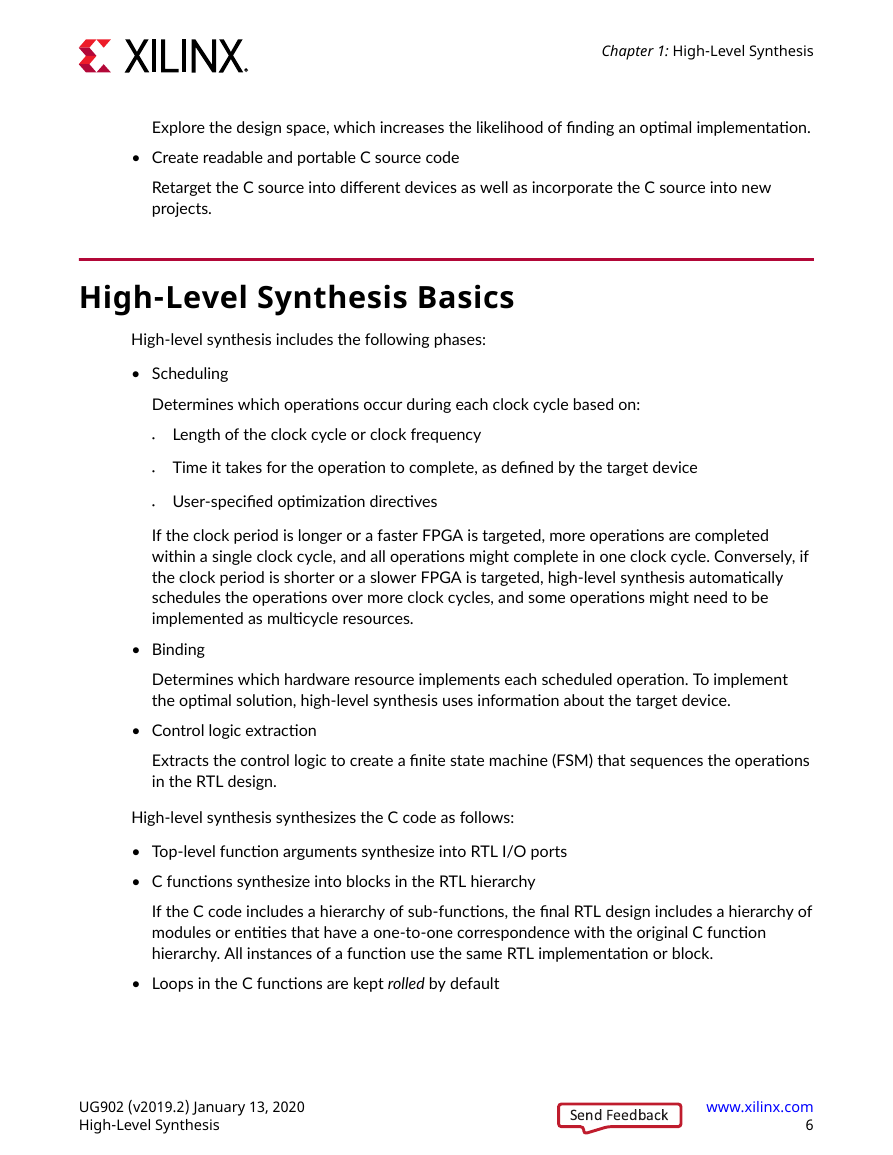
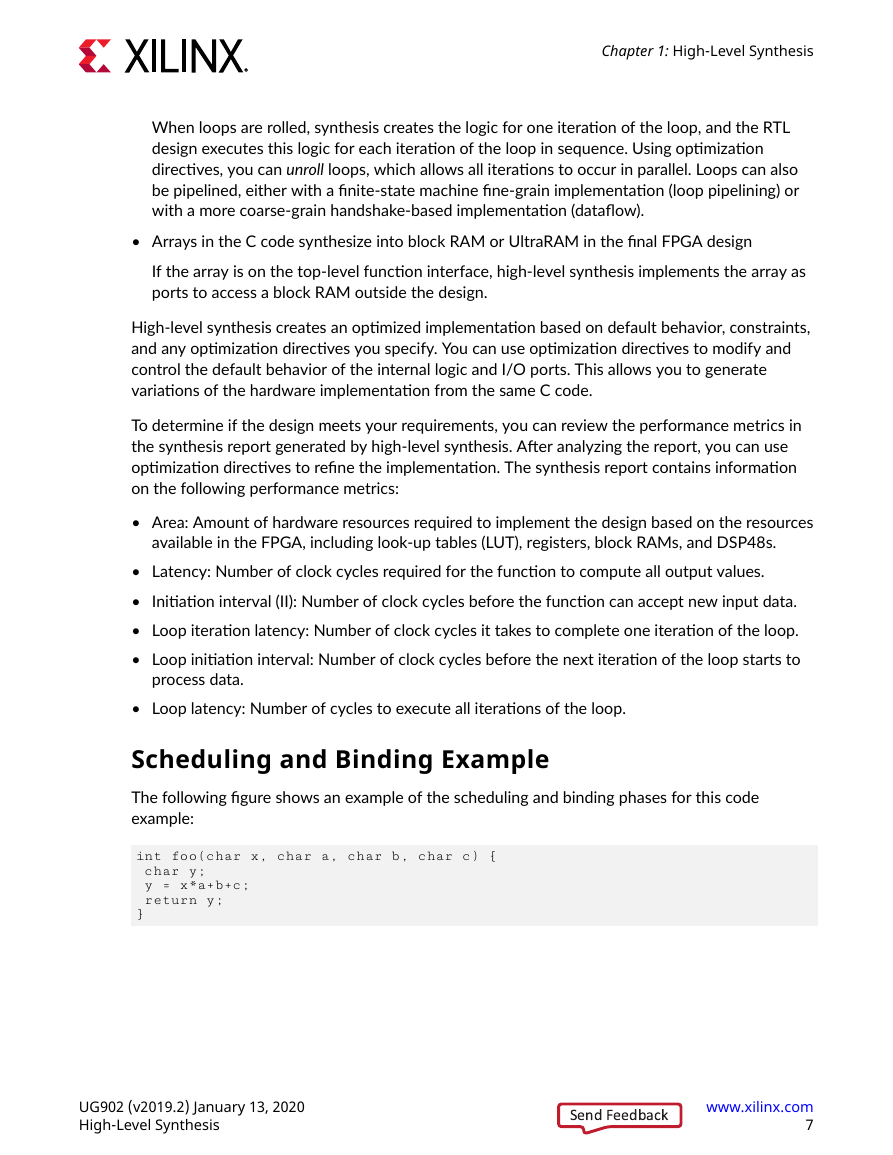
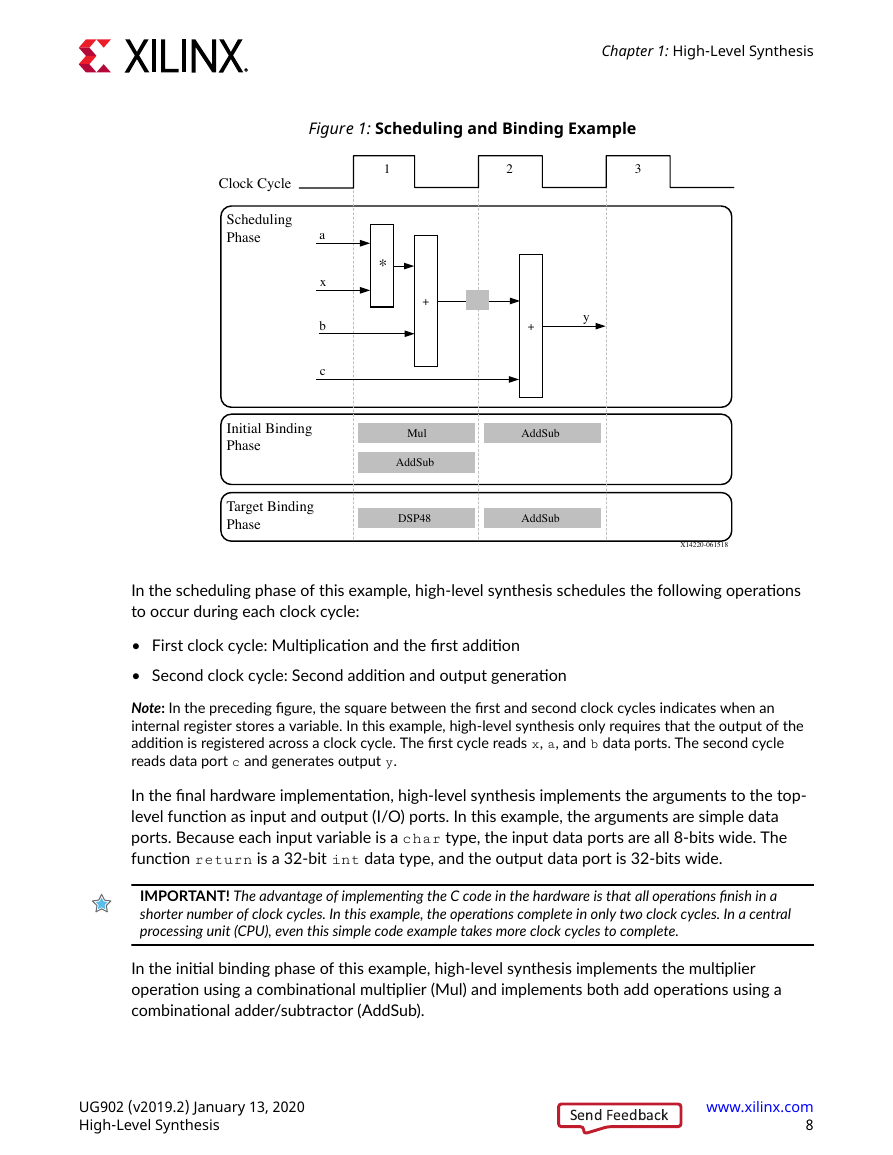








 2023年江西萍乡中考道德与法治真题及答案.doc
2023年江西萍乡中考道德与法治真题及答案.doc 2012年重庆南川中考生物真题及答案.doc
2012年重庆南川中考生物真题及答案.doc 2013年江西师范大学地理学综合及文艺理论基础考研真题.doc
2013年江西师范大学地理学综合及文艺理论基础考研真题.doc 2020年四川甘孜小升初语文真题及答案I卷.doc
2020年四川甘孜小升初语文真题及答案I卷.doc 2020年注册岩土工程师专业基础考试真题及答案.doc
2020年注册岩土工程师专业基础考试真题及答案.doc 2023-2024学年福建省厦门市九年级上学期数学月考试题及答案.doc
2023-2024学年福建省厦门市九年级上学期数学月考试题及答案.doc 2021-2022学年辽宁省沈阳市大东区九年级上学期语文期末试题及答案.doc
2021-2022学年辽宁省沈阳市大东区九年级上学期语文期末试题及答案.doc 2022-2023学年北京东城区初三第一学期物理期末试卷及答案.doc
2022-2023学年北京东城区初三第一学期物理期末试卷及答案.doc 2018上半年江西教师资格初中地理学科知识与教学能力真题及答案.doc
2018上半年江西教师资格初中地理学科知识与教学能力真题及答案.doc 2012年河北国家公务员申论考试真题及答案-省级.doc
2012年河北国家公务员申论考试真题及答案-省级.doc 2020-2021学年江苏省扬州市江都区邵樊片九年级上学期数学第一次质量检测试题及答案.doc
2020-2021学年江苏省扬州市江都区邵樊片九年级上学期数学第一次质量检测试题及答案.doc 2022下半年黑龙江教师资格证中学综合素质真题及答案.doc
2022下半年黑龙江教师资格证中学综合素质真题及答案.doc